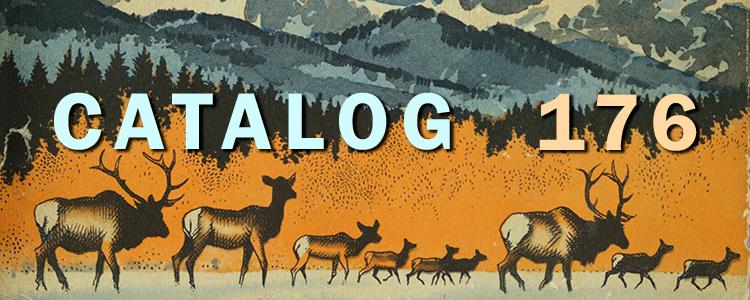 Subscribe
Subscribe
E-list # 205
Nature / Conservation
 St. Louis, CNI/CEI, 1963-1968. 7 issues of this magazine founded by Barry Commoner, which bore three different names in its publishing history. An incomplete run: Nuclear Information, August 1963; and Scientist and Citizen for May/June 1965; April and May 1966; January 1967; January/February and December 1968. A publication of the Committee for Nuclear Information, a non-governmental organization devoted to reducing the danger of nuclear war and informing the public of the dangers of nuclear technology. The first issue here was published during the Kennedy administration, the same month that the first Nuclear Test Ban Treaty was signed between the U.S., the U.K., and the Soviet Union, an effort that had been underway for more than eight years at that point. Commoner was one of the most well-informed and highly educated of the anti-nuclear activists at that time, and as a result he retains a unique place in the history of American environmentalism: when he died in 2012, the New York Times obituary characterized him as "a founder of modern ecology and one of its most provocative thinkers and mobilizers in making environmentalism a people’s political cause." Cover stains to the earliest issue; else the lot is near fine in stapled wrappers.
[#035866]
$350
St. Louis, CNI/CEI, 1963-1968. 7 issues of this magazine founded by Barry Commoner, which bore three different names in its publishing history. An incomplete run: Nuclear Information, August 1963; and Scientist and Citizen for May/June 1965; April and May 1966; January 1967; January/February and December 1968. A publication of the Committee for Nuclear Information, a non-governmental organization devoted to reducing the danger of nuclear war and informing the public of the dangers of nuclear technology. The first issue here was published during the Kennedy administration, the same month that the first Nuclear Test Ban Treaty was signed between the U.S., the U.K., and the Soviet Union, an effort that had been underway for more than eight years at that point. Commoner was one of the most well-informed and highly educated of the anti-nuclear activists at that time, and as a result he retains a unique place in the history of American environmentalism: when he died in 2012, the New York Times obituary characterized him as "a founder of modern ecology and one of its most provocative thinkers and mobilizers in making environmentalism a people’s political cause." Cover stains to the earliest issue; else the lot is near fine in stapled wrappers.
[#035866]
$350
(ABBEY, Edward)
 (Denver), Mountain Gazette, 1974. A chapter from Abbey's The Monkey Wrench Gang, published here the year before the book's publication, and with variations from the final text. Pages 5-7 of this issue, with the last text column of page 5 printed a bit off the edge of the page. 10" x 15"; splitting along the stapled spine. Address label removal evident on front cover; previously folded. A good copy of a fragile publication that represents an early version of what may be Abbey's most influential book, which helped instigate "monkeywrenching" as environmental protest, and helped birth Earth First!, the most famous, or notorious, of the radical environmental groups.
[#036518]
$500
(Denver), Mountain Gazette, 1974. A chapter from Abbey's The Monkey Wrench Gang, published here the year before the book's publication, and with variations from the final text. Pages 5-7 of this issue, with the last text column of page 5 printed a bit off the edge of the page. 10" x 15"; splitting along the stapled spine. Address label removal evident on front cover; previously folded. A good copy of a fragile publication that represents an early version of what may be Abbey's most influential book, which helped instigate "monkeywrenching" as environmental protest, and helped birth Earth First!, the most famous, or notorious, of the radical environmental groups.
[#036518]
$500
ADAMS, Richard and LOCKLEY, Ronald
 NY, Knopf, 1983. The first American edition. Warmly inscribed by Richard Adams, author of Watership Down, "To Marilyn with gratitude and all good wishes," and dated December, 1982. Note that the title page of this US edition gives the publication date of 1983, but the copyright page and the dust jacket both bear a 1982 date. Adams and Lockley, in alternating voices throughout the text, tell the story of their 6500 mile journey from Tierra del Fuego, along the coasts and seas of Antarctica, to the southern tip of New Zealand. Heavily illustrated with photographs by Peter Hirst-Smith. Near fine in a very good dust jacket with shallow edge wear. Scarce signed.
[#036189]
$300
NY, Knopf, 1983. The first American edition. Warmly inscribed by Richard Adams, author of Watership Down, "To Marilyn with gratitude and all good wishes," and dated December, 1982. Note that the title page of this US edition gives the publication date of 1983, but the copyright page and the dust jacket both bear a 1982 date. Adams and Lockley, in alternating voices throughout the text, tell the story of their 6500 mile journey from Tierra del Fuego, along the coasts and seas of Antarctica, to the southern tip of New Zealand. Heavily illustrated with photographs by Peter Hirst-Smith. Near fine in a very good dust jacket with shallow edge wear. Scarce signed.
[#036189]
$300
BARKER, Rocky
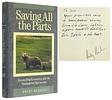 Washington, DC, Island Press, (1993). A measured look at the "jobs vs. the environment" discussions of the time. Signed by the author. Also warmly inscribed in a different pen, but likely in the same hand, as Barker's is the only signature. Near fine in a fine dust jacket.
[#036519]
$350
Washington, DC, Island Press, (1993). A measured look at the "jobs vs. the environment" discussions of the time. Signed by the author. Also warmly inscribed in a different pen, but likely in the same hand, as Barker's is the only signature. Near fine in a fine dust jacket.
[#036519]
$350
BOERKER, Richard H. D.
 Chapel Hill, University of North Carolina Press, (1945). Boerker studied forestry at Dartmouth and Yale and received a Masters of Science in Forestry from the University of Michigan, going on to work for the U.S. Forest Service in California, Wyoming, and Colorado. This book argues for replacing the concept of "conservation" with "forest restoration for multiple use, with human welfare as the ultimate object." Signed by the author, "Yours, R.H.D. Boerker." Owner name and date (August 1945) written above. Illustrated with photographs. Foxing to endpapers and bump to spine base; a very good copy in a good dust jacket with wear at the spine ends and along the rear flap fold. A scarce, early publication on this subject, produced during wartime. Uncommon in the original edition or in jacket, let alone signed.
[#036520]
$500
Chapel Hill, University of North Carolina Press, (1945). Boerker studied forestry at Dartmouth and Yale and received a Masters of Science in Forestry from the University of Michigan, going on to work for the U.S. Forest Service in California, Wyoming, and Colorado. This book argues for replacing the concept of "conservation" with "forest restoration for multiple use, with human welfare as the ultimate object." Signed by the author, "Yours, R.H.D. Boerker." Owner name and date (August 1945) written above. Illustrated with photographs. Foxing to endpapers and bump to spine base; a very good copy in a good dust jacket with wear at the spine ends and along the rear flap fold. A scarce, early publication on this subject, produced during wartime. Uncommon in the original edition or in jacket, let alone signed.
[#036520]
$500
BRINK, Wellington
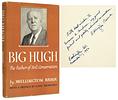 NY, Macmillan, 1951. A biography of Hugh Bennett, head of the federal Soil Erosion Service and a founder of the Soil Conservation Society of America. With an introduction by Louis Bromfield, Pulitzer Prize winning author of Early Autumn and founder of the experimental Malabar Farm. Warmly inscribed by the author, Wellington Brink, to a co-worker in 1952. Hugh Bennett was Brink's boss at the renamed Soil Conservation Service. Fine in a very good, lightly edgeworn dust jacket.
[#036521]
$250
NY, Macmillan, 1951. A biography of Hugh Bennett, head of the federal Soil Erosion Service and a founder of the Soil Conservation Society of America. With an introduction by Louis Bromfield, Pulitzer Prize winning author of Early Autumn and founder of the experimental Malabar Farm. Warmly inscribed by the author, Wellington Brink, to a co-worker in 1952. Hugh Bennett was Brink's boss at the renamed Soil Conservation Service. Fine in a very good, lightly edgeworn dust jacket.
[#036521]
$250
BURROUGHS, John
 Boston, Houghton Mifflin, 1922. Posthumously published writings by Burroughs on Emerson and Thoreau, as well as on Darwin, and on death. Preface by Clara Barrus, who was Burroughs' companion, biographer, and literary executor. This copy is inscribed by Barrus to Dr. John Johnston, co-author of Visits to Walt Whitman in 1890-1891: "Dr. J. Johnstone - Dear friend, Let this "Last Harvest" of Our Friend come to you as from his hand, and as a souvenir of that happy time when you visited him in his river home. You and W.W. and J.B. found one another out by 'faint indirections,'/ [quoting Whitman] 'And I, when I meet you mean to discover you by the like in you.'/ Clara Barrus/ Woodchuck Lodge/ Roxbury NY/ August 28, 1922." A half-page of notes on the rear endpages, presumably by Johnston, along with penciled underlinings and marginal notations in text. A very good, moderately shelfworn copy, lacking the dust jacket. An excellent association copy.
[#035120]
$750
Boston, Houghton Mifflin, 1922. Posthumously published writings by Burroughs on Emerson and Thoreau, as well as on Darwin, and on death. Preface by Clara Barrus, who was Burroughs' companion, biographer, and literary executor. This copy is inscribed by Barrus to Dr. John Johnston, co-author of Visits to Walt Whitman in 1890-1891: "Dr. J. Johnstone - Dear friend, Let this "Last Harvest" of Our Friend come to you as from his hand, and as a souvenir of that happy time when you visited him in his river home. You and W.W. and J.B. found one another out by 'faint indirections,'/ [quoting Whitman] 'And I, when I meet you mean to discover you by the like in you.'/ Clara Barrus/ Woodchuck Lodge/ Roxbury NY/ August 28, 1922." A half-page of notes on the rear endpages, presumably by Johnston, along with penciled underlinings and marginal notations in text. A very good, moderately shelfworn copy, lacking the dust jacket. An excellent association copy.
[#035120]
$750
(BURROUGHS, John)
 Boston, Houghton Mifflin, 1912. Burroughs provides an 8-page introduction to this collection of "Outdoor Scenes and Thoughts From the Writings of Walt Whitman," as compiled by Waldo R. Browne. Says Burroughs, in part, "As a poet he did not specialize upon flowers or birds or scenery, or any of the mere prettiness of nature, but he thought of wholes, he tried himself by wholes, he emulated the insouciance, the impartiality, the mass movements of the earth." Trace shelf wear; a very near fine copy in a good dust jacket: chipped at both spine ends and rear corners, and fragile at the folds. Uncommon in the original edition; scarce in any jacket.
[#035119]
$300
Boston, Houghton Mifflin, 1912. Burroughs provides an 8-page introduction to this collection of "Outdoor Scenes and Thoughts From the Writings of Walt Whitman," as compiled by Waldo R. Browne. Says Burroughs, in part, "As a poet he did not specialize upon flowers or birds or scenery, or any of the mere prettiness of nature, but he thought of wholes, he tried himself by wholes, he emulated the insouciance, the impartiality, the mass movements of the earth." Trace shelf wear; a very near fine copy in a good dust jacket: chipped at both spine ends and rear corners, and fragile at the folds. Uncommon in the original edition; scarce in any jacket.
[#035119]
$300On Sale: $195
(BURROUGHS, John). EASTMAN, Fred
 NY, Abingdon-Cokesbury Press, (1939). A biography of four men: John Burroughs, Abraham Lincoln, Leo Tolstoy, and Graham Taylor. The Burroughs section runs 35 pages: not definitive, but relatively early, and in interesting company. Small ink stain on the title page, and a few pages of text have random ink markings, not affecting legibility; owner name on flyleaf; near fine in a very good, shallowly edge-chipped dust jacket. Uncommon in jacket.
[#035986]
$125
NY, Abingdon-Cokesbury Press, (1939). A biography of four men: John Burroughs, Abraham Lincoln, Leo Tolstoy, and Graham Taylor. The Burroughs section runs 35 pages: not definitive, but relatively early, and in interesting company. Small ink stain on the title page, and a few pages of text have random ink markings, not affecting legibility; owner name on flyleaf; near fine in a very good, shallowly edge-chipped dust jacket. Uncommon in jacket.
[#035986]
$125
(BURROUGHS, John). KELLEY, Elizabeth Burroughs
 South Brunswick/NY, A.S. Barnes, (1969). Kelley, the author of John Burroughs: Naturalist, the director of the John Burroughs Memorial Association, and Burroughs' grand-daughter, here introduces and illustrates a selection of 14 pieces by Burroughs. Also includes an 8-page photo insert. Signed by Elizabeth Burroughs Kelley. Near fine in a very good, rubbed dust jacket, with tears at the spine extremities that have been internally tape-mended.
[#036196]
$150
South Brunswick/NY, A.S. Barnes, (1969). Kelley, the author of John Burroughs: Naturalist, the director of the John Burroughs Memorial Association, and Burroughs' grand-daughter, here introduces and illustrates a selection of 14 pieces by Burroughs. Also includes an 8-page photo insert. Signed by Elizabeth Burroughs Kelley. Near fine in a very good, rubbed dust jacket, with tears at the spine extremities that have been internally tape-mended.
[#036196]
$150
(CARSON, Rachel)
 (NY), (Century Co.), (1919). Carson's third appearance in print: a brief story (about 200 words) about the effect that America's entry into WWI has on a group of French soldiers, published when she was 11 years old, and winner of the magazine's Gold Badge. St. Nicholas magazine made a point of publishing work by children, and between 1907 and 1917 winners of the magazine's badges included William Faulkner, F. Scott Fitzgerald, E.E. Cummings, Edna St. Vincent Millay, and E.B. White -- all of them under 18 at the time. Not a nature story, but Carson's lasting impact came from both her skills as a scientist and as a writer, and as such her early talent and successes are worth celebrating. Small stain to spine; covers separating from text block; a good copy only, but a fragile WWI-vintage magazine, which is uncommon these days outside of bound sets.
[#036522]
$500
(NY), (Century Co.), (1919). Carson's third appearance in print: a brief story (about 200 words) about the effect that America's entry into WWI has on a group of French soldiers, published when she was 11 years old, and winner of the magazine's Gold Badge. St. Nicholas magazine made a point of publishing work by children, and between 1907 and 1917 winners of the magazine's badges included William Faulkner, F. Scott Fitzgerald, E.E. Cummings, Edna St. Vincent Millay, and E.B. White -- all of them under 18 at the time. Not a nature story, but Carson's lasting impact came from both her skills as a scientist and as a writer, and as such her early talent and successes are worth celebrating. Small stain to spine; covers separating from text block; a good copy only, but a fragile WWI-vintage magazine, which is uncommon these days outside of bound sets.
[#036522]
$500
(CARSON, Rachel). STERLING, Philip
 NY, Thomas Y. Crowell, (1970). Apparently the first of many biographies of Carson, preceding even Paul Brooks' The House of Life (1972). This volume was published in Crowell's "Women of America" series. Mild splaying to boards; near fine in a very good, price-clipped dust jacket with light rubbing and wear to the edges and folds. Uncommon in the first printing, with many copies having gone to libraries.
[#035988]
$225
NY, Thomas Y. Crowell, (1970). Apparently the first of many biographies of Carson, preceding even Paul Brooks' The House of Life (1972). This volume was published in Crowell's "Women of America" series. Mild splaying to boards; near fine in a very good, price-clipped dust jacket with light rubbing and wear to the edges and folds. Uncommon in the first printing, with many copies having gone to libraries.
[#035988]
$225
CHAPMAN, Dan
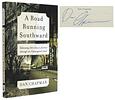 Washington, DC, Island Press, (2022). Chapman recreates, by automobile, John Muir's 1867 "thousand mile walk" from Louisville, Kentucky to the Gulf of Mexico, assessing the toll of the previous 150 years on the region's ecosystems. Signed by the author. Fine in a fine dust jacket.
[#036523]
$250
Washington, DC, Island Press, (2022). Chapman recreates, by automobile, John Muir's 1867 "thousand mile walk" from Louisville, Kentucky to the Gulf of Mexico, assessing the toll of the previous 150 years on the region's ecosystems. Signed by the author. Fine in a fine dust jacket.
[#036523]
$250
COLE, Joanna and DEGEN, Bruce
 NY, Scholastic Press, (2010). Signed by both authors in the month after publication. Ms. Frizzle takes the Magic School Bus on a tour of all things related to climate change: the melting Arctic, rising sea levels, disappearing glaciers, disappearing coral reefs, extreme weather patterns, crop devastation, loss of habitat, the greenhouse effect, fossil fuels, alternative energy solutions, conservation efforts, and individual and government responsibility, (and yes, the bus is a hybrid by the end of the tour). Published in the early years of the Obama administration, this title is an indicator of the issue of climate change becoming mainstream, and it retains some of the optimism of the time. Slight splaying to boards; else fine in a fine dust jacket. Scarce signed.
[#035972]
$250
NY, Scholastic Press, (2010). Signed by both authors in the month after publication. Ms. Frizzle takes the Magic School Bus on a tour of all things related to climate change: the melting Arctic, rising sea levels, disappearing glaciers, disappearing coral reefs, extreme weather patterns, crop devastation, loss of habitat, the greenhouse effect, fossil fuels, alternative energy solutions, conservation efforts, and individual and government responsibility, (and yes, the bus is a hybrid by the end of the tour). Published in the early years of the Obama administration, this title is an indicator of the issue of climate change becoming mainstream, and it retains some of the optimism of the time. Slight splaying to boards; else fine in a fine dust jacket. Scarce signed.
[#035972]
$250
COMMONER, Barry
 St. Louis, Center for the Biology of Natural Systems, 1975. The partial text (so stated, by design) of Commoner's address before the National Press Photographers Association Education Seminar in Jackson Hole in 1975, on the subject of nuclear energy. Commoner derides the lack of attention paid to the relationship between ecosystems and economic systems. Solutions are given in the following part of the address, not included here. Stapled wrappers: foxing to cover, rust to staples; near fine. No copies in OCLC.
[#036236]
$250
St. Louis, Center for the Biology of Natural Systems, 1975. The partial text (so stated, by design) of Commoner's address before the National Press Photographers Association Education Seminar in Jackson Hole in 1975, on the subject of nuclear energy. Commoner derides the lack of attention paid to the relationship between ecosystems and economic systems. Solutions are given in the following part of the address, not included here. Stapled wrappers: foxing to cover, rust to staples; near fine. No copies in OCLC.
[#036236]
$250
CRUICKSHANK, Helen G.
 NY, Macmillan, 1948. Winner of the 1949 John Burroughs Medal. "Bird Experiences in Florida," with text by Helen G. Cruickshank and photographs by the author's husband, Allan D. Cruickshank, who was the official photographer of the National Audubon Society. This copy is signed by both Cruickshanks. Allan has added "Dum Vivimus Vivamus" ("While we live, let us live") below his signature. A fine copy in a very good, unevenly faded, price-clipped dust jacket with moderate edge wear.
[#034647]
$300
NY, Macmillan, 1948. Winner of the 1949 John Burroughs Medal. "Bird Experiences in Florida," with text by Helen G. Cruickshank and photographs by the author's husband, Allan D. Cruickshank, who was the official photographer of the National Audubon Society. This copy is signed by both Cruickshanks. Allan has added "Dum Vivimus Vivamus" ("While we live, let us live") below his signature. A fine copy in a very good, unevenly faded, price-clipped dust jacket with moderate edge wear.
[#034647]
$300On Sale: $195
DARLING, Louis
 NY, William Morrow, 1965. Winner of the 1966 John Burroughs Medal; a book about the life of herring gulls on an island off the Maine coast. Illustrated with photographs and drawings by Darling, and with a foreword by Roger Tory Peterson, whose recommendation of Louis and Lois Darling to Rachel Carson had resulted in the Darlings illustrating Silent Spring in 1962. An uncommon first edition. Slightly musty; near fine in a very good dust jacket with a couple of small edge chips on the rear panel.
[#035124]
$125
NY, William Morrow, 1965. Winner of the 1966 John Burroughs Medal; a book about the life of herring gulls on an island off the Maine coast. Illustrated with photographs and drawings by Darling, and with a foreword by Roger Tory Peterson, whose recommendation of Louis and Lois Darling to Rachel Carson had resulted in the Darlings illustrating Silent Spring in 1962. An uncommon first edition. Slightly musty; near fine in a very good dust jacket with a couple of small edge chips on the rear panel.
[#035124]
$125
DAVIS, Devra
 (NY), Basic Books, (2002). A sobering account of how environmental pollution affects public health and the corporate and political obstacles to action. Signed by the author. Laid into the book is the program for a seminar by Davis given in Rochester in 2003. The program is filled with the participant's notes; the book has some foxing to the top edge and is otherwise fine in a fine dust jacket.
[#036434]
$275
(NY), Basic Books, (2002). A sobering account of how environmental pollution affects public health and the corporate and political obstacles to action. Signed by the author. Laid into the book is the program for a seminar by Davis given in Rochester in 2003. The program is filled with the participant's notes; the book has some foxing to the top edge and is otherwise fine in a fine dust jacket.
[#036434]
$275
DeBUYS, William
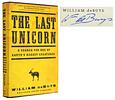 NY, Little, Brown, (2015). A search for the critically endangered saola, or Asian unicorn. Reminiscent of Peter Matthiessen's The Snow Leopard. Signed by the author. Fine in a fine dust jacket, with blurbs by George Schaller (Matthiessen's companion on the snow leopard journey), Bill McKibben, Alan Weisman, and Ali McGraw, among others.
[#036524]
$175
NY, Little, Brown, (2015). A search for the critically endangered saola, or Asian unicorn. Reminiscent of Peter Matthiessen's The Snow Leopard. Signed by the author. Fine in a fine dust jacket, with blurbs by George Schaller (Matthiessen's companion on the snow leopard journey), Bill McKibben, Alan Weisman, and Ali McGraw, among others.
[#036524]
$175
DUFFY, Trent
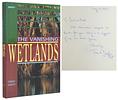 NY, Franklin Watts, (1994). A volume in the Franklin Watts "Impact" series, this one an introduction to the importance of wetlands, their flora and fauna, their future, and the politics of preservation. Warmly inscribed by the author (to film critic Pauline Kael) in the year of publication. Trace top edge foxing, else fine in a fine dust jacket.
[#035491]
$125
NY, Franklin Watts, (1994). A volume in the Franklin Watts "Impact" series, this one an introduction to the importance of wetlands, their flora and fauna, their future, and the politics of preservation. Warmly inscribed by the author (to film critic Pauline Kael) in the year of publication. Trace top edge foxing, else fine in a fine dust jacket.
[#035491]
$125
ELLIS, Richard
 Washington, DC, Island Press, (2003). Ellis looks at the pending fates of fish, marine mammals, marine birds, turtles, and coral reefs. Inscribed by the author in the year of publication. Foxing to the edges of the text block; near fine in a fine dust jacket.
[#036526]
$250
Washington, DC, Island Press, (2003). Ellis looks at the pending fates of fish, marine mammals, marine birds, turtles, and coral reefs. Inscribed by the author in the year of publication. Foxing to the edges of the text block; near fine in a fine dust jacket.
[#036526]
$250
GOLDFARB, Ben
 White River Junction, Chelsea Green Publishing, (2018). Golbfarb examines the ways in which beavers can be the solution to conservation problems and landscape ecology. Signed by the author on a beaver bookplate. Blurbs by Bill McKibben, Carl Safina, Sy Montgomery, and others. Winner of the PEN E. O. Wilson Award for science writing. Fine in a fine dust jacket.
[#036195]
$175
White River Junction, Chelsea Green Publishing, (2018). Golbfarb examines the ways in which beavers can be the solution to conservation problems and landscape ecology. Signed by the author on a beaver bookplate. Blurbs by Bill McKibben, Carl Safina, Sy Montgomery, and others. Winner of the PEN E. O. Wilson Award for science writing. Fine in a fine dust jacket.
[#036195]
$175
(GOODALL, Jane)
 NY, Holt Rinehart Winston, (1965). Goodall's first book appearance: the uncorrected proof copy (divided into two volumes), of this collection of field studies of monkeys and apes, edited by Irven DeVore of Harvard University. Includes (in the "second half"), "Chimpanzees of the Gombe Stream Reserve," a nearly 50-page report by Goodall, on observations she made between June 1960 and December 1962, covering topics such as locomotion, communication, group structure, socialization, mating, nesting, grooming, feeding, tool use, and of course, tool-making. Goodall, despite lacking formal education at the time, had arranged a meeting with anthropologist Louis Leakey in 1957, and (after deflecting his advances) she became his assistant/secretary. In 1960, after Leakey had sent Goodall to London for a crash course in primates, he sent her to Tanzania to study chimps. (Tanzania, unwilling to allow Goodall to travel alone, required that she have a companion: Goodall brought her mother.) By year's end, Goodall had observed chimps not only using tools for feeding, but creating tools for this purpose, causing Leakey to write to her in a telegram: "Now, we must redefine man, redefine tool, or accept chimpanzees as humans." Two volumes (stamped "first half" and "second half") in tall, comb-bound green wrappers. The proof does not include Goodall's images. Business card of an editor at Holt, Rinehart and Winston stapled to the front cover of the first volume; each volume is near fine. Goodall's pioneering work on the Gombe chimpanzees continues to this day and is the longest continuous study of any animal in their natural habitat in history.
[#035126]
$750
NY, Holt Rinehart Winston, (1965). Goodall's first book appearance: the uncorrected proof copy (divided into two volumes), of this collection of field studies of monkeys and apes, edited by Irven DeVore of Harvard University. Includes (in the "second half"), "Chimpanzees of the Gombe Stream Reserve," a nearly 50-page report by Goodall, on observations she made between June 1960 and December 1962, covering topics such as locomotion, communication, group structure, socialization, mating, nesting, grooming, feeding, tool use, and of course, tool-making. Goodall, despite lacking formal education at the time, had arranged a meeting with anthropologist Louis Leakey in 1957, and (after deflecting his advances) she became his assistant/secretary. In 1960, after Leakey had sent Goodall to London for a crash course in primates, he sent her to Tanzania to study chimps. (Tanzania, unwilling to allow Goodall to travel alone, required that she have a companion: Goodall brought her mother.) By year's end, Goodall had observed chimps not only using tools for feeding, but creating tools for this purpose, causing Leakey to write to her in a telegram: "Now, we must redefine man, redefine tool, or accept chimpanzees as humans." Two volumes (stamped "first half" and "second half") in tall, comb-bound green wrappers. The proof does not include Goodall's images. Business card of an editor at Holt, Rinehart and Winston stapled to the front cover of the first volume; each volume is near fine. Goodall's pioneering work on the Gombe chimpanzees continues to this day and is the longest continuous study of any animal in their natural habitat in history.
[#035126]
$750
GRIFFIN, Susan
 NY, Harper& Row, (1978). An early ecofeminist tract, born from the observation that the patriarchal subjugation of women paralleled the patriarchal subjugation of nature. Signed by the author. With the ownership signature of environmental philosopher Gail Stenstad. Small inked-out spot on front pastedown; sunning to edges of text block, with light foxing to top edge; a very good copy in a very good, spine and edge-sunned dust jacket. Her first book of nonfiction, and uncommon signed.
[#035146]
SOLD
NY, Harper& Row, (1978). An early ecofeminist tract, born from the observation that the patriarchal subjugation of women paralleled the patriarchal subjugation of nature. Signed by the author. With the ownership signature of environmental philosopher Gail Stenstad. Small inked-out spot on front pastedown; sunning to edges of text block, with light foxing to top edge; a very good copy in a very good, spine and edge-sunned dust jacket. Her first book of nonfiction, and uncommon signed.
[#035146]
SOLD
GRISCOM, Ludlow and EMERSON, Guy
 Martha's Vineyard, Privately Printed, 1959. A complete reference, including a history of birding on the island; an annotated systematic list of all recorded birds; a list of summer, winter and permanent residents as well as migrants and accidentals; where to look for birds and who has seen them; and a large fold-out birdwatcher's map of the island. Inscribed in 1961 by both the co-author Guy Emerson and by Henry Beetle Hough, who contributes the first essay in the book -- "A Ticket to Martha's Vineyard" -- to Eleanor Herrick Stickney, a lifelong, avid bird-watcher who was an ornithologist for the Yale Peabody Museum of Natural History for 30 years, in charge of the collection of specimens there and director of the library. Henry Beetle Hough was the longtime owner, editor and publisher of the Vineyard Gazette and a Pulitzer Prize winner. A fine copy in a very good, spine-sunned, lightly rubbed dust jacket with a few short tears near the spine crown. An excellent association copy.
[#035601]
$300
Martha's Vineyard, Privately Printed, 1959. A complete reference, including a history of birding on the island; an annotated systematic list of all recorded birds; a list of summer, winter and permanent residents as well as migrants and accidentals; where to look for birds and who has seen them; and a large fold-out birdwatcher's map of the island. Inscribed in 1961 by both the co-author Guy Emerson and by Henry Beetle Hough, who contributes the first essay in the book -- "A Ticket to Martha's Vineyard" -- to Eleanor Herrick Stickney, a lifelong, avid bird-watcher who was an ornithologist for the Yale Peabody Museum of Natural History for 30 years, in charge of the collection of specimens there and director of the library. Henry Beetle Hough was the longtime owner, editor and publisher of the Vineyard Gazette and a Pulitzer Prize winner. A fine copy in a very good, spine-sunned, lightly rubbed dust jacket with a few short tears near the spine crown. An excellent association copy.
[#035601]
$300
HADDAD, Nick
 Princeton, Princeton University Press, (2019). The quest to save the six rarest butterflies. Inscribed by the author. Fine in a fine dust jacket, with blurbs by Elizabeth Kolbert, David Quammen, and Carl Safina, among others. Lower corners tapped, else fine in a fine dust jacket. Uncommon signed.
[#036529]
$200
Princeton, Princeton University Press, (2019). The quest to save the six rarest butterflies. Inscribed by the author. Fine in a fine dust jacket, with blurbs by Elizabeth Kolbert, David Quammen, and Carl Safina, among others. Lower corners tapped, else fine in a fine dust jacket. Uncommon signed.
[#036529]
$200
HANSON, Thor
 NY, Basic Books, (2018). The John Burroughs Medal-winning author of Feathers takes on the long evolution and recent decline of the insects responsible for a third of our food supply, besides being fascinating in their own right. This copy is signed by the author, with a drawing of a bee alongside his signature. Fine in a near fine dust jacket with the upper outer corners tapped.
[#036437]
$200
NY, Basic Books, (2018). The John Burroughs Medal-winning author of Feathers takes on the long evolution and recent decline of the insects responsible for a third of our food supply, besides being fascinating in their own right. This copy is signed by the author, with a drawing of a bee alongside his signature. Fine in a near fine dust jacket with the upper outer corners tapped.
[#036437]
$200
HANSON, Thor
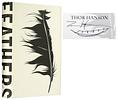 NY, Basic Books, (2011). Winner of the 2013 John Burroughs Medal, this is a far-reaching, high-flying story of an evolutionary marvel: the feather is light, strong, flexible, insulating, water-repellent, and also decorative. Signed by the author, with a drawing of a feather. Blurbs by Peter Matthiessen, Bernd Heinrich and Robert Michael Pyle, among others. Fine in a fine dust jacket, with a book review laid in. Uncommon signed.
[#036436]
$250
NY, Basic Books, (2011). Winner of the 2013 John Burroughs Medal, this is a far-reaching, high-flying story of an evolutionary marvel: the feather is light, strong, flexible, insulating, water-repellent, and also decorative. Signed by the author, with a drawing of a feather. Blurbs by Peter Matthiessen, Bernd Heinrich and Robert Michael Pyle, among others. Fine in a fine dust jacket, with a book review laid in. Uncommon signed.
[#036436]
$250
HARRISON, C. William
 NY, Julian Messner, (1963). Soil, forests, waterways, and wildlife: Harrison writes with the hope that "the mistakes of the fathers will never be repeated by their sons and daughters." Illustrated with photographs. Owner name in pencil; near fine in a very good, spine-faded and price-clipped dust jacket. Uncommon in jacket.
[#036530]
$125
NY, Julian Messner, (1963). Soil, forests, waterways, and wildlife: Harrison writes with the hope that "the mistakes of the fathers will never be repeated by their sons and daughters." Illustrated with photographs. Owner name in pencil; near fine in a very good, spine-faded and price-clipped dust jacket. Uncommon in jacket.
[#036530]
$125
HORNADAY, William T.
 NY, New York Zoological Society, 1913. First edition, published by the New York Zoological Society, and likely published simultaneously with the Scribner edition (both state January 1913 on the copyright page). Hornaday was a zoologist and influential conservationist who advocated for game laws and wildlife protection. This copy has a gift inscription on the front flyleaf, a long chip to page 153, and a 1/4" loss of spine cloth at the crown. A good copy, without dust jacket. Uncommon in the Zoological Society imprint.
[#036532]
$200
NY, New York Zoological Society, 1913. First edition, published by the New York Zoological Society, and likely published simultaneously with the Scribner edition (both state January 1913 on the copyright page). Hornaday was a zoologist and influential conservationist who advocated for game laws and wildlife protection. This copy has a gift inscription on the front flyleaf, a long chip to page 153, and a 1/4" loss of spine cloth at the crown. A good copy, without dust jacket. Uncommon in the Zoological Society imprint.
[#036532]
$200
HUXLEY, Aldous
 [Berkeley], Ecology Center, ca. 1969. The author of Brave New World takes on the threats posed by rising populations and accompanying preoccupations with politics and power rather than with democracy and ecology (with special reference given in the text to Russia and China). First thus: issued as Ecology Center Reprint 7 (reprinted from Center Magazine). Near fine in stapled wrappers.
[#035313]
$75
[Berkeley], Ecology Center, ca. 1969. The author of Brave New World takes on the threats posed by rising populations and accompanying preoccupations with politics and power rather than with democracy and ecology (with special reference given in the text to Russia and China). First thus: issued as Ecology Center Reprint 7 (reprinted from Center Magazine). Near fine in stapled wrappers.
[#035313]
$75
JACOBS, Chip and KELLY, William J.
 Woodstock, Overlook Press, (2008). Signed by Kelly and inscribed by Jacobs: "Mickey - a brown drama for a warming age. Hope it's instructive." The authors examine decades of fits and starts in clearing the Californian air in this "cautionary tale of environmental crisis." Tanning to page edges, else fine in a fine dust jacket bearing an Independent Publisher Book Awards label. Scarce signed.
[#035992]
$250
Woodstock, Overlook Press, (2008). Signed by Kelly and inscribed by Jacobs: "Mickey - a brown drama for a warming age. Hope it's instructive." The authors examine decades of fits and starts in clearing the Californian air in this "cautionary tale of environmental crisis." Tanning to page edges, else fine in a fine dust jacket bearing an Independent Publisher Book Awards label. Scarce signed.
[#035992]
$250
JERNBERG, Albert W
 NY, Richard R. Smith, 1941. Jernberg, a reserve U.S. Army Air Corps officer, reports on his four years commanding several Civilian Conservation Corps companies, including a camp for Black enrollees. Inscribed by the author in 1946: "With best wishes to Dr. Ralph E. Smith who, literaly [sic] looked inside this author's head." Near fine, lacking the dust jacket.
[#036533]
$375
NY, Richard R. Smith, 1941. Jernberg, a reserve U.S. Army Air Corps officer, reports on his four years commanding several Civilian Conservation Corps companies, including a camp for Black enrollees. Inscribed by the author in 1946: "With best wishes to Dr. Ralph E. Smith who, literaly [sic] looked inside this author's head." Near fine, lacking the dust jacket.
[#036533]
$375
KAUPANGER, Olin L
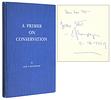 (Minneapolis), (Federal Cartridge Corporation), (1952). Kaupanger was a "self-styled conservation watchdog for more than 40 years," according to his obituary, and secretary of the Minnesota Emergency Conservation Committee. This primer on conservation, covering such topics as soil, water, flora, fauna, education, and administration, was published by his employer, the Federal Cartridge Corporation, and carries a foreword by the company's founder. Federal is still in business, selling guns and ammunition, and touts on its website "a century of commitment to conservation." Inscribed by Kaupanger in 1957. Slight shelf wear; near fine, without dust jacket, likely as issued.
[#036534]
$300
(Minneapolis), (Federal Cartridge Corporation), (1952). Kaupanger was a "self-styled conservation watchdog for more than 40 years," according to his obituary, and secretary of the Minnesota Emergency Conservation Committee. This primer on conservation, covering such topics as soil, water, flora, fauna, education, and administration, was published by his employer, the Federal Cartridge Corporation, and carries a foreword by the company's founder. Federal is still in business, selling guns and ammunition, and touts on its website "a century of commitment to conservation." Inscribed by Kaupanger in 1957. Slight shelf wear; near fine, without dust jacket, likely as issued.
[#036534]
$300
(KEARTON, Richard and Cherry). WHITE, Gilbert
 London, Arrowsmith, (1924). First thus: a reissue of the Keartons' 1902 edition of "the most widely known book on the joys of outdoor life in the English language," according to Richard Kearton's two-page introduction to this volume, which talks of changes in Selborne, and the influx of American visitors. Still including his introduction to the 1902 edition, and with a different selection of 85 photographs by the brothers, Richard and Cherry Kearton, from the 123 that appeared in the earlier edition. Inscribed by Richard Kearton in the year of publication to his "old friend, Leonard P. Moore, Esq." Offsetting to inscription page; heavy foxing to page edges and prelims; a bit of sunning to cloth; and a short tear at the rear upper joint. A good copy. Laid in is a flyer for a 1993 exhibition marking the bicentenary of the death of Gilbert White.
[#033522]
$350
London, Arrowsmith, (1924). First thus: a reissue of the Keartons' 1902 edition of "the most widely known book on the joys of outdoor life in the English language," according to Richard Kearton's two-page introduction to this volume, which talks of changes in Selborne, and the influx of American visitors. Still including his introduction to the 1902 edition, and with a different selection of 85 photographs by the brothers, Richard and Cherry Kearton, from the 123 that appeared in the earlier edition. Inscribed by Richard Kearton in the year of publication to his "old friend, Leonard P. Moore, Esq." Offsetting to inscription page; heavy foxing to page edges and prelims; a bit of sunning to cloth; and a short tear at the rear upper joint. A good copy. Laid in is a flyer for a 1993 exhibition marking the bicentenary of the death of Gilbert White.
[#033522]
$350
KILHAM, Lawrence
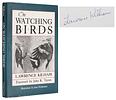 Chelsea, Chelsea Green Publishing Company, (1988). Winner of the 1989 John Burroughs Medal. Signed by the author on the title page. As the title suggests, not just a book about birds, but also about how to observe them. With a foreword by the 1971 Burroughs Medal winner, John K. Terres. Light foredge foxing; nonauthorial gift inscription on the front flyleaf. Near fine in a near fine dust jacket.
[#036197]
$350
Chelsea, Chelsea Green Publishing Company, (1988). Winner of the 1989 John Burroughs Medal. Signed by the author on the title page. As the title suggests, not just a book about birds, but also about how to observe them. With a foreword by the 1971 Burroughs Medal winner, John K. Terres. Light foredge foxing; nonauthorial gift inscription on the front flyleaf. Near fine in a near fine dust jacket.
[#036197]
$350
KINNEY, J.P
 NY, John Wiley & Sons, 1917. A thorough, state-by-state survey of enactments of the legislatures of the 48 states and by the Federal Congress regarding the conservation and administration of forest resources. Tipped in at the front hinge is the cover of a Cornell University bulletin on the topic of forest legislation, and this bulletin has been inscribed by Kinney to William Heritage. For three decades, Kinney was engaged in forestry and conservation activities for the Bureau of Indian Affairs; Heritage worked for the Department of the Interior's Indian Service. Heritage's ownership signature appears in the book, which is near fine, without dust jacket, likely as issued.
[#036535]
$500
NY, John Wiley & Sons, 1917. A thorough, state-by-state survey of enactments of the legislatures of the 48 states and by the Federal Congress regarding the conservation and administration of forest resources. Tipped in at the front hinge is the cover of a Cornell University bulletin on the topic of forest legislation, and this bulletin has been inscribed by Kinney to William Heritage. For three decades, Kinney was engaged in forestry and conservation activities for the Bureau of Indian Affairs; Heritage worked for the Department of the Interior's Indian Service. Heritage's ownership signature appears in the book, which is near fine, without dust jacket, likely as issued.
[#036535]
$500
LANSDOWNE, Fenwick
 [Canada], Maclean's, ca. 1957. A portfolio of bird watercolors by Lansdowne, first published in Maclean's Magazine in April, 1957. Lansdowne was a self-taught Canadian bird artist, whose work was often compared, favorably, to that of Audubon. Six 11" x 14-1/2" plates, plus an illustrated biography/colophon of equal size. Four of the plates have paintings of individual birds; two show two birds each, and one of these has been cut along the designated line. Two additional paintings adorn the portfolio's covers. Several of the plates have been previously hung and show pinholes or faint tape marks. Light rubbing to the covers; very good or better. Uncommon: five copies found in OCLC.
[#035028]
$350
[Canada], Maclean's, ca. 1957. A portfolio of bird watercolors by Lansdowne, first published in Maclean's Magazine in April, 1957. Lansdowne was a self-taught Canadian bird artist, whose work was often compared, favorably, to that of Audubon. Six 11" x 14-1/2" plates, plus an illustrated biography/colophon of equal size. Four of the plates have paintings of individual birds; two show two birds each, and one of these has been cut along the designated line. Two additional paintings adorn the portfolio's covers. Several of the plates have been previously hung and show pinholes or faint tape marks. Light rubbing to the covers; very good or better. Uncommon: five copies found in OCLC.
[#035028]
$350
LOPEZ, Barry
 Eugene, Lone Goose, 1997. Copy "A" of 16 participants' copies of this limited edition of this essay from Crossing Open Ground, later published in a trade edition by the University of Georgia Press. Here issued with twenty-three 11-3/4" x 11" woodblock images by Robin Eschner, which are hinged in a continuous presentation almost 22 feet long, encompassing the text. An elaborate production, involving a number of individuals prominent in the book arts, in addition to Lopez and Eschner: Charles Hobson, the designer, whose work is included in the collections of the Whitney Museum and the National Gallery of Art, among others; Sandy Tilcock, the publisher and boxmaker; Susan Acker, the letterpress printer; Nora Pauwells, the relief edition printer; and John DeMerritt, the binder, who was President of the Hand Bookbinders of California. The total edition was 66 copies: this is Copy A of 16 lettered copies signed by Lopez and Eschner and including a unique tire-tread print from Lopez's Toyota 4-Runner, the vehicle used in the journey from Oregon to Indiana that is described in the story. Fine, in a clamshell box.
[#035200]
$3,500
Eugene, Lone Goose, 1997. Copy "A" of 16 participants' copies of this limited edition of this essay from Crossing Open Ground, later published in a trade edition by the University of Georgia Press. Here issued with twenty-three 11-3/4" x 11" woodblock images by Robin Eschner, which are hinged in a continuous presentation almost 22 feet long, encompassing the text. An elaborate production, involving a number of individuals prominent in the book arts, in addition to Lopez and Eschner: Charles Hobson, the designer, whose work is included in the collections of the Whitney Museum and the National Gallery of Art, among others; Sandy Tilcock, the publisher and boxmaker; Susan Acker, the letterpress printer; Nora Pauwells, the relief edition printer; and John DeMerritt, the binder, who was President of the Hand Bookbinders of California. The total edition was 66 copies: this is Copy A of 16 lettered copies signed by Lopez and Eschner and including a unique tire-tread print from Lopez's Toyota 4-Runner, the vehicle used in the journey from Oregon to Indiana that is described in the story. Fine, in a clamshell box.
[#035200]
$3,500
LOPEZ, Barry
 NY, Scribner's, 1978. The uncorrected proof copy of his third book, winner of the John Burroughs Medal as the best work of natural history published that year, and a nominee for the National Book Award. A remarkable and unlikely bestseller: the book was reprinted numerous times, brought into a new edition by the publisher (in a smaller format), picked up by the Book of the Month Club, and became a significant commercial success in a trade paperback edition as well. It attempts to explore the wolf both in the objective world and in the subjective ways that humans have seen and imagined it throughout history. This proof copy was printed with the original title, The Book of the Wolf, on the cover and the title page; the ultimate title has been written in by hand on the cover. A fragile, padbound proof with covers beginning to separate at the spine base; several scuff and spots to cover and a handful of page corners turned. Name of author and reviewer Ethel Jacobson across the front cover. A very good copy. A landmark in natural history writing.
[#036475]
$350
NY, Scribner's, 1978. The uncorrected proof copy of his third book, winner of the John Burroughs Medal as the best work of natural history published that year, and a nominee for the National Book Award. A remarkable and unlikely bestseller: the book was reprinted numerous times, brought into a new edition by the publisher (in a smaller format), picked up by the Book of the Month Club, and became a significant commercial success in a trade paperback edition as well. It attempts to explore the wolf both in the objective world and in the subjective ways that humans have seen and imagined it throughout history. This proof copy was printed with the original title, The Book of the Wolf, on the cover and the title page; the ultimate title has been written in by hand on the cover. A fragile, padbound proof with covers beginning to separate at the spine base; several scuff and spots to cover and a handful of page corners turned. Name of author and reviewer Ethel Jacobson across the front cover. A very good copy. A landmark in natural history writing.
[#036475]
$350
McKIBBEN, Bill
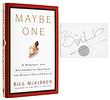 NY, Simon & Schuster, (1998). The author of The End of Nature and co-founder of the climate organization 350.org here makes an environmental argument for having only one child. Since this book was published, in 1998, the world population has increased 33%, from 6 billion to 8 billion. Signed by the author. Fine in a fine dust jacket.
[#035596]
$125
NY, Simon & Schuster, (1998). The author of The End of Nature and co-founder of the climate organization 350.org here makes an environmental argument for having only one child. Since this book was published, in 1998, the world population has increased 33%, from 6 billion to 8 billion. Signed by the author. Fine in a fine dust jacket.
[#035596]
$125
McPHEE, John
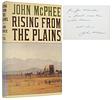 NY, Farrar Straus, (1986). The third of McPhee's geology books, later incorporated into the Pulitzer Prize-winning compendium of his geological writings, Annals of the Former World. This copy is inscribed by McPhee to Joe McCrindle, founder of the Transatlantic Review, who published McPhee's "The Fair of San Gennaro" in 1961, four years before his first book publication, which may explain the geological inscription: "For Joe McCrindle/ a friend since the middle Miocene/ best always/ John McPhee." Slight foxing to the top edge, else fine in a fine dust jacket with just a hint of spine fading. A nice association.
[#036492]
$450
NY, Farrar Straus, (1986). The third of McPhee's geology books, later incorporated into the Pulitzer Prize-winning compendium of his geological writings, Annals of the Former World. This copy is inscribed by McPhee to Joe McCrindle, founder of the Transatlantic Review, who published McPhee's "The Fair of San Gennaro" in 1961, four years before his first book publication, which may explain the geological inscription: "For Joe McCrindle/ a friend since the middle Miocene/ best always/ John McPhee." Slight foxing to the top edge, else fine in a fine dust jacket with just a hint of spine fading. A nice association.
[#036492]
$450
MEADER, Fred
 [Alaska], [Self-Published], [ca. 1967-1970s]. Apparently a homemade production of these three essays by Meader: "The Wilderness and Post-Civilized Man" (first published in Snowy Egret, 1966); "A Return to Wilderness" (first published in Alaska Review, 1965); and "The Coming Obsolescence of Man" (previously unpublished?). Only one copy listed in OCLC. From a 1974 article about Meader in Newsweek: “After five years of odd jobs, European travel and an abortive try at homesteading in Canada, a vague sense of dissatisfaction with civilized life drove them [Meader and his wife, Elaine] to Alaska...For most of the past 15 years they have lived in the remote Brooks Range of the Arctic interior, 50 miles from their nearest neighbor and 250 miles from the nearest road...Their home was a three-room log cabin; their diet was meat, fish and berries. They fashioned bowls from spruce roots and made clothing from caribou hides..." Their lives were documented in the film "Year of the Caribou" (also released as "The Alaska Wilderness Adventure"). 19 pages, 8-1/2" x 11" sheets, side-stapled with blue front cover and no rear cover, possibly as issued. Several small penciled notes to text; inked price to front cover. A very good copy. Scarce: OCLC lists only one copy in institutional holdings (UC-Davis).
[#035129]
$300
[Alaska], [Self-Published], [ca. 1967-1970s]. Apparently a homemade production of these three essays by Meader: "The Wilderness and Post-Civilized Man" (first published in Snowy Egret, 1966); "A Return to Wilderness" (first published in Alaska Review, 1965); and "The Coming Obsolescence of Man" (previously unpublished?). Only one copy listed in OCLC. From a 1974 article about Meader in Newsweek: “After five years of odd jobs, European travel and an abortive try at homesteading in Canada, a vague sense of dissatisfaction with civilized life drove them [Meader and his wife, Elaine] to Alaska...For most of the past 15 years they have lived in the remote Brooks Range of the Arctic interior, 50 miles from their nearest neighbor and 250 miles from the nearest road...Their home was a three-room log cabin; their diet was meat, fish and berries. They fashioned bowls from spruce roots and made clothing from caribou hides..." Their lives were documented in the film "Year of the Caribou" (also released as "The Alaska Wilderness Adventure"). 19 pages, 8-1/2" x 11" sheets, side-stapled with blue front cover and no rear cover, possibly as issued. Several small penciled notes to text; inked price to front cover. A very good copy. Scarce: OCLC lists only one copy in institutional holdings (UC-Davis).
[#035129]
$300
MEDSGER, Oliver P.
 NY, Frederick Warne, (1931). The 1933 John Burroughs Medal Winner. Inscribed by the author: "For Helen E. Nickerson, with kind regards of her friend, the author, Oliver Perry Medsger/ State College, Pa, July 12, 1934." Medsger won the Burroughs Medal for the 4-volume sequence of Spring, Summer, Autumn, Fall, of which this one, Spring, was the first. This is a near fine copy, with minor wear to the corners and spine ends, in a very good dust jacket with light wear to the spine ends and folds. Scarce in jacket, and remarkably so signed.
[#036491]
$750
NY, Frederick Warne, (1931). The 1933 John Burroughs Medal Winner. Inscribed by the author: "For Helen E. Nickerson, with kind regards of her friend, the author, Oliver Perry Medsger/ State College, Pa, July 12, 1934." Medsger won the Burroughs Medal for the 4-volume sequence of Spring, Summer, Autumn, Fall, of which this one, Spring, was the first. This is a near fine copy, with minor wear to the corners and spine ends, in a very good dust jacket with light wear to the spine ends and folds. Scarce in jacket, and remarkably so signed.
[#036491]
$750
MOWAT, Farley
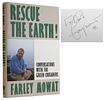 (Toronto), McClelland & Stewart, (1990). The Canadian author of Never Cry Wolf, among many others, here interviews environmental activists including Ron Burchell (The Sierra Club); Monte Hummel (World Wildlife Fund); Stephen Best (International Wildlife Coalition); and others, including David Suzuki, Peter Singer, and Elizabeth May. Inscribed by Mowat in the year of publication. Fine in a fine dust jacket.
[#035603]
$125
(Toronto), McClelland & Stewart, (1990). The Canadian author of Never Cry Wolf, among many others, here interviews environmental activists including Ron Burchell (The Sierra Club); Monte Hummel (World Wildlife Fund); Stephen Best (International Wildlife Coalition); and others, including David Suzuki, Peter Singer, and Elizabeth May. Inscribed by Mowat in the year of publication. Fine in a fine dust jacket.
[#035603]
$125
MOWREY, Marc and REDMOND, Tim
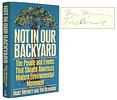 NY, Morrow, (1993). A wide-ranging compilation of small and large battles fought since the first Earth Day: chlorofluorocarbons, malathion, Exxon, ozone, Glen Canyon, Love Canal, redwoods, plastics, offshore drilling, greenhouse gases, etc. Signed by both authors. One page corner creased; else fine in a fine dust jacket. Blurb by Jerry Brown.
[#036537]
$350
NY, Morrow, (1993). A wide-ranging compilation of small and large battles fought since the first Earth Day: chlorofluorocarbons, malathion, Exxon, ozone, Glen Canyon, Love Canal, redwoods, plastics, offshore drilling, greenhouse gases, etc. Signed by both authors. One page corner creased; else fine in a fine dust jacket. Blurb by Jerry Brown.
[#036537]
$350
MURIE, Margaret and Olaus
 NY, Knopf, 1966. Inscribed by Margaret "Mardy" Murie, conservationist, naturalist, and recipient of the Audubon Medal, the John Muir Award, and the Presidential Medal of Freedom: "For Joan Wilson/ Every good wish from many more happy trips in 'Wapiti Wilderness'/ Mardy Murie." This book was co-authored with her husband, Olaus, who died prior to publication. Mardy was known as the "Grandmother of the Conservation Movement" and was a mentor to a generation of younger environmentalists. A very near fine copy in a very good, lightly edgeworn, price-clipped dust jacket, close to splitting at the front spine fold.
[#035997]
SOLD
NY, Knopf, 1966. Inscribed by Margaret "Mardy" Murie, conservationist, naturalist, and recipient of the Audubon Medal, the John Muir Award, and the Presidential Medal of Freedom: "For Joan Wilson/ Every good wish from many more happy trips in 'Wapiti Wilderness'/ Mardy Murie." This book was co-authored with her husband, Olaus, who died prior to publication. Mardy was known as the "Grandmother of the Conservation Movement" and was a mentor to a generation of younger environmentalists. A very near fine copy in a very good, lightly edgeworn, price-clipped dust jacket, close to splitting at the front spine fold.
[#035997]
SOLD
NABHAN, Gary and BUCHMANN, Stephen L.
 Washington, D.C., Island Press, [1996]. A broadside promoting the authors' book The Forgotten Pollinators, an attempt to remind people that plants (and food) depend on threatened mammals, birds, butterflies and bees as pollinators. Signed by both Nabhan and Buchmann. 8-1/2" x 16-1/2". Rolled, else fine.
[#033884]
$85
Washington, D.C., Island Press, [1996]. A broadside promoting the authors' book The Forgotten Pollinators, an attempt to remind people that plants (and food) depend on threatened mammals, birds, butterflies and bees as pollinators. Signed by both Nabhan and Buchmann. 8-1/2" x 16-1/2". Rolled, else fine.
[#033884]
$85
OSBORN, Fairfield
 Boston, Little Brown, (1948). A prescient book (1948) by the President of the New York Zoological Society, warning of the effects of the increasing global depletion of natural resources: water, soil, forests, and biodiversity. Blurbs by Aldous Huxley and Eleanor Roosevelt, among others. Less common than it seems, as many "firsts" fail to state "first edition" on the copyright page. Penciled notes on front flyleaf and underlinings in text; a very good copy in a good, edge-chipped dust jacket rubbed along the folds.
[#035998]
$350
Boston, Little Brown, (1948). A prescient book (1948) by the President of the New York Zoological Society, warning of the effects of the increasing global depletion of natural resources: water, soil, forests, and biodiversity. Blurbs by Aldous Huxley and Eleanor Roosevelt, among others. Less common than it seems, as many "firsts" fail to state "first edition" on the copyright page. Penciled notes on front flyleaf and underlinings in text; a very good copy in a good, edge-chipped dust jacket rubbed along the folds.
[#035998]
$350
REISNER, Marc
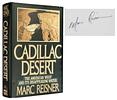 NY, Viking, (1986). An environmental classic, listed on Modern Library's top 100 nonfiction books of the 20th century and a finalist for the National Book Critics Circle Award. A revised edition was issued in 1993; a documentary film was made in 1997. This copy is signed by Reisner, who died of cancer in 2000. Fine in a very near fine dust jacket with a bit of shelfwear and some age-toning to the flaps. Very uncommon signed.
[#036441]
$750
NY, Viking, (1986). An environmental classic, listed on Modern Library's top 100 nonfiction books of the 20th century and a finalist for the National Book Critics Circle Award. A revised edition was issued in 1993; a documentary film was made in 1997. This copy is signed by Reisner, who died of cancer in 2000. Fine in a very near fine dust jacket with a bit of shelfwear and some age-toning to the flaps. Very uncommon signed.
[#036441]
$750
RICH, Nathaniel
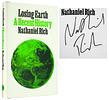 NY, MCD/Farrar Straus Giroux, (2019). Rich's searing recounting of the 1980s -- the decade when we almost stopped climate change, and how it all derailed. Expanded here from a 2018 article in The New York Times Magazine. Signed by the author. Some toning to page edges and a bit of fading to the boards; near fine in a fine dust jacket. Uncommon signed.
[#036408]
$275
NY, MCD/Farrar Straus Giroux, (2019). Rich's searing recounting of the 1980s -- the decade when we almost stopped climate change, and how it all derailed. Expanded here from a 2018 article in The New York Times Magazine. Signed by the author. Some toning to page edges and a bit of fading to the boards; near fine in a fine dust jacket. Uncommon signed.
[#036408]
$275
RIENOW, Robert and Leona Train
 NY, Dial Press, (1967). A fascinating look at all the ways our (then) rising standards of living would eventually contribute to our demise (via water and air pollution, pesticides, dwindling resources, etc.) Stamp of the Foreign Policy Research Institute on the front flyleaf, and the book is inscribed by Robert Rienow to the Institute's founder, Robert Strausz-Hupe. Very good in a very good, rubbed and price-clipped dust jacket.
[#036538]
SOLD
NY, Dial Press, (1967). A fascinating look at all the ways our (then) rising standards of living would eventually contribute to our demise (via water and air pollution, pesticides, dwindling resources, etc.) Stamp of the Foreign Policy Research Institute on the front flyleaf, and the book is inscribed by Robert Rienow to the Institute's founder, Robert Strausz-Hupe. Very good in a very good, rubbed and price-clipped dust jacket.
[#036538]
SOLD
ROUECHE, Berton
 Boston, Little Brown, (1968). A collection of essays by the New Yorker writer, most on the theme of wildlife conservation. Inscribed by the author. Roueche was perhaps better known as a medical writer: his book The Medical Detectives was one of the inspirations for the television series House and he won several awards for his writings in that field. Near fine in a very good, rubbed and price-clipped dust jacket.
[#036202]
$275
Boston, Little Brown, (1968). A collection of essays by the New Yorker writer, most on the theme of wildlife conservation. Inscribed by the author. Roueche was perhaps better known as a medical writer: his book The Medical Detectives was one of the inspirations for the television series House and he won several awards for his writings in that field. Near fine in a very good, rubbed and price-clipped dust jacket.
[#036202]
$275
SCHALLER, George B.
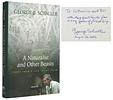 San Francisco, Sierra Club Books, (2007). A retrospective collection of pieces from Schaller's life in the field, with a new introduction by the author for each chapter. Warmly inscribed by Schaller in 2009: "To Catherine and Bill/ with deep gratitude for many years of friendship." Fine in a fine dust jacket, with blurbs by a virtual Who's Who of environmental writing: Peter Matthiessen; Jane Goodall; Bill McKibben; and Edward O. Wilson. Schaller, among many other accomplishments and activities, accompanied Matthiessen on the trip documented in the National Book Award-winning, The Snow Leopard.
[#036480]
$300
San Francisco, Sierra Club Books, (2007). A retrospective collection of pieces from Schaller's life in the field, with a new introduction by the author for each chapter. Warmly inscribed by Schaller in 2009: "To Catherine and Bill/ with deep gratitude for many years of friendship." Fine in a fine dust jacket, with blurbs by a virtual Who's Who of environmental writing: Peter Matthiessen; Jane Goodall; Bill McKibben; and Edward O. Wilson. Schaller, among many other accomplishments and activities, accompanied Matthiessen on the trip documented in the National Book Award-winning, The Snow Leopard.
[#036480]
$300
STEINBERG, Ted
 NY, Oxford University Press, 2002. A sweeping and illuminating recounting of the environmental factors that shaped American history along side the social, political, and economic forces. Inscribed by the author. Fine in a fine dust jacket.
[#036539]
$225
NY, Oxford University Press, 2002. A sweeping and illuminating recounting of the environmental factors that shaped American history along side the social, political, and economic forces. Inscribed by the author. Fine in a fine dust jacket.
[#036539]
$225
STEWART, Darryl
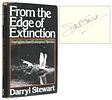 (Toronto), McClelland & Stewart, (1978). The success stories (as of 1978) of 25 North American species that had been endangered. Covers the whooping crane; Florida manatee; eastern timber wolf; polar bear; peregrine falcon; bison; trumpeter swan; etc. Signed by the author. Fine in a very good, price-clipped dust jacket, with minor edge wear that has been "touched up" with black marker.
[#036540]
$350
(Toronto), McClelland & Stewart, (1978). The success stories (as of 1978) of 25 North American species that had been endangered. Covers the whooping crane; Florida manatee; eastern timber wolf; polar bear; peregrine falcon; bison; trumpeter swan; etc. Signed by the author. Fine in a very good, price-clipped dust jacket, with minor edge wear that has been "touched up" with black marker.
[#036540]
$350
STUTZ, Bruce
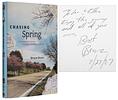 NY, Scribner, (2006). In the spirit of Edwin Way Teale's North with the Spring (Florida to New Hampshire, 1951), Stutz takes a (very indirect) 3-month journey chasing spring from Louisiana to Alaska, 55 years later. Inscribed by the author: "To Lee & Ellen/ Enjoy this journey and all of your own, Best/ Bruce/ 7/27/07." Fine in a fine dust jacket.
[#036204]
$225
NY, Scribner, (2006). In the spirit of Edwin Way Teale's North with the Spring (Florida to New Hampshire, 1951), Stutz takes a (very indirect) 3-month journey chasing spring from Louisiana to Alaska, 55 years later. Inscribed by the author: "To Lee & Ellen/ Enjoy this journey and all of your own, Best/ Bruce/ 7/27/07." Fine in a fine dust jacket.
[#036204]
$225
THOMAS, Lewis
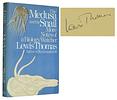 NY, Viking, (1979). His second collection of essays, after The Lives of the Cell won two National Book Awards in 1975. Signed by the author. Fine in a near fine dust jacket with a short, closed edge tear to the upper front panel.
[#036205]
$250
NY, Viking, (1979). His second collection of essays, after The Lives of the Cell won two National Book Awards in 1975. Signed by the author. Fine in a near fine dust jacket with a short, closed edge tear to the upper front panel.
[#036205]
$250
WALLACE, David Rains
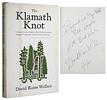 San Francisco, Sierra Club/Yolla Bolly Press, (1983). His third book, winner of the1984 John Burroughs Medal. Inscribed by the author: "To Raymond and Mary Ellen Haight/ with best wishes/ David Rains Wallace/ 3/17/83." Evolution, mythology, and Sasquatch mix amid the ecosystems of the Northwest's Klamath Mountains. Published by the Sierra Club. A fine copy in a very good, unlaminated jacket with strips of sunning, light edge wear and a 2" tear at the lower rear spine fold. Scarce signed. The Haights were long-time residents of San Francisco: Raymond's great grandfather, Henry Huntley Haight, was governor of California, and among other accomplishments, has a famous street named for him.
[#036000]
$350
San Francisco, Sierra Club/Yolla Bolly Press, (1983). His third book, winner of the1984 John Burroughs Medal. Inscribed by the author: "To Raymond and Mary Ellen Haight/ with best wishes/ David Rains Wallace/ 3/17/83." Evolution, mythology, and Sasquatch mix amid the ecosystems of the Northwest's Klamath Mountains. Published by the Sierra Club. A fine copy in a very good, unlaminated jacket with strips of sunning, light edge wear and a 2" tear at the lower rear spine fold. Scarce signed. The Haights were long-time residents of San Francisco: Raymond's great grandfather, Henry Huntley Haight, was governor of California, and among other accomplishments, has a famous street named for him.
[#036000]
$350
WALLJASPER, Jay
 NY, The New Press, (2010). A former editor of the Utne Reader explains "how to save the economy, the environment, the internet, democracy, our communities, and everything else that belongs to all of us" by way of acknowledging shared ownership and shared responsibility. Dozens of short articles written by more than two dozen authors, with illustrations and a resource guide, and featuring an introduction by Bill McKibben. Inscribed by Walljasper, with the exhortation "Viva la Commons!" Fine in wrappers.
[#034650]
$100
NY, The New Press, (2010). A former editor of the Utne Reader explains "how to save the economy, the environment, the internet, democracy, our communities, and everything else that belongs to all of us" by way of acknowledging shared ownership and shared responsibility. Dozens of short articles written by more than two dozen authors, with illustrations and a resource guide, and featuring an introduction by Bill McKibben. Inscribed by Walljasper, with the exhortation "Viva la Commons!" Fine in wrappers.
[#034650]
$100
WORKMAN, Fanny Bullock
 (n.p.), Spottiswoode, 1914. The first separate appearance, reprinted, with additions, from the February 1914 Geographical Journal, and inscribed by Workman to J.P. (John Percy) Farrar on the front cover. Fanny Bullock Workman, suffragist, cyclist, mountaineer, cartographer, travel writer and Fellow of the Royal Geographical Society, spent eight seasons exploring glaciers and mountains of the Karakoram and Punjab Himalaya between 1898 and 1912 (accompanied by her husband and countless porters). She first became aware of the Siachen Glacier (the second longest outside of the Polar regions, at 45 miles, and dividing India and Pakistan) during one of her and her husband's multi-thousand mile bicycle tours, which were the subject of her early books. An accomplished climber, Workman attained the women's altitude record (20,278 ft) in 1906, in the Karakoram. In 1912, she led the expedition to map the Siachen, becoming perhaps best known for unfurling a newspaper there, at nearly 21000 feet, with the headline "Votes for Women." This offprint includes approximately 18 photographs and a full fold out map inside the rear cover. Several instances of marginal notes, perhaps by Farrar, a climber who was an original member of the Mount Everest Committee and responsible for recruiting George Mallory to the 1921 reconnaissance expedition. The covers and several rear signatures are detached; the front cover is chipped; the text, photos and map are all preserved, although the tissue guards over the photos have darkened. A fair copy only, but scarce, and with a rare signature.
[#036508]
SOLD
(n.p.), Spottiswoode, 1914. The first separate appearance, reprinted, with additions, from the February 1914 Geographical Journal, and inscribed by Workman to J.P. (John Percy) Farrar on the front cover. Fanny Bullock Workman, suffragist, cyclist, mountaineer, cartographer, travel writer and Fellow of the Royal Geographical Society, spent eight seasons exploring glaciers and mountains of the Karakoram and Punjab Himalaya between 1898 and 1912 (accompanied by her husband and countless porters). She first became aware of the Siachen Glacier (the second longest outside of the Polar regions, at 45 miles, and dividing India and Pakistan) during one of her and her husband's multi-thousand mile bicycle tours, which were the subject of her early books. An accomplished climber, Workman attained the women's altitude record (20,278 ft) in 1906, in the Karakoram. In 1912, she led the expedition to map the Siachen, becoming perhaps best known for unfurling a newspaper there, at nearly 21000 feet, with the headline "Votes for Women." This offprint includes approximately 18 photographs and a full fold out map inside the rear cover. Several instances of marginal notes, perhaps by Farrar, a climber who was an original member of the Mount Everest Committee and responsible for recruiting George Mallory to the 1921 reconnaissance expedition. The covers and several rear signatures are detached; the front cover is chipped; the text, photos and map are all preserved, although the tissue guards over the photos have darkened. A fair copy only, but scarce, and with a rare signature.
[#036508]
SOLD
ZWINGER, Ann and TEALE, Edwin Way
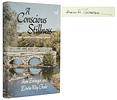 NY, Harper & Row, (1982). Zwinger, winner of the John Burroughs Medal, and Teale, winner of the Pulitzer Prize, collaborated on this book about the two rivers that join to form the Concord River, beloved by Thoreau. This copy is signed by Zwinger. A landmark collaboration by two of the most respected naturalists writing at the time. Zwinger, whose writings had generally been about the West, was president of the Thoreau Society at the time this book was published. Foredge foxing and shallow loss of color to boards; a very good copy in a very good dust jacket with wear at the crown and a small sticker removal abrasion on the front panel.
[#036489]
$300
NY, Harper & Row, (1982). Zwinger, winner of the John Burroughs Medal, and Teale, winner of the Pulitzer Prize, collaborated on this book about the two rivers that join to form the Concord River, beloved by Thoreau. This copy is signed by Zwinger. A landmark collaboration by two of the most respected naturalists writing at the time. Zwinger, whose writings had generally been about the West, was president of the Thoreau Society at the time this book was published. Foredge foxing and shallow loss of color to boards; a very good copy in a very good dust jacket with wear at the crown and a small sticker removal abrasion on the front panel.
[#036489]
$300
ZWINGER, Ann and WILLARD, Beatrice
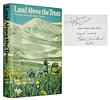 NY, Harper & Row, (1972). First printing (full number line at rear of book) of Zwinger's second book, following Beyond the Aspen Grove, and preceding her John Burroughs Medal winning book Run, River, Run. This title is a guide to alpine tundra in the U.S. and features 24 color plates and 230 of Zwinger's line drawings. Inscribed by Zwinger and signed by Willard in 1978. Multiple instances of faint highlighting in text, thus very good in a very good, lightly edgeworn and price-clipped dust jacket.
[#036442]
$275
NY, Harper & Row, (1972). First printing (full number line at rear of book) of Zwinger's second book, following Beyond the Aspen Grove, and preceding her John Burroughs Medal winning book Run, River, Run. This title is a guide to alpine tundra in the U.S. and features 24 color plates and 230 of Zwinger's line drawings. Inscribed by Zwinger and signed by Willard in 1978. Multiple instances of faint highlighting in text, thus very good in a very good, lightly edgeworn and price-clipped dust jacket.
[#036442]
$275On Sale: $179
For notifications of our sale lists, new arrivals, new catalogs, or other e-lists, subscribe to our email list:
